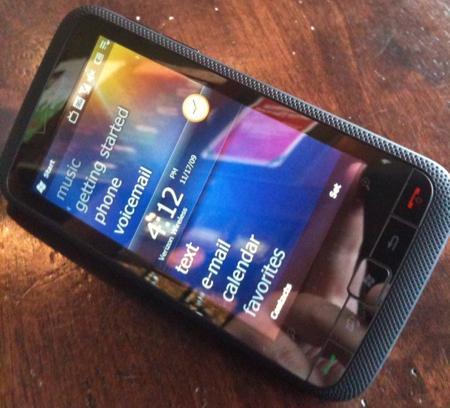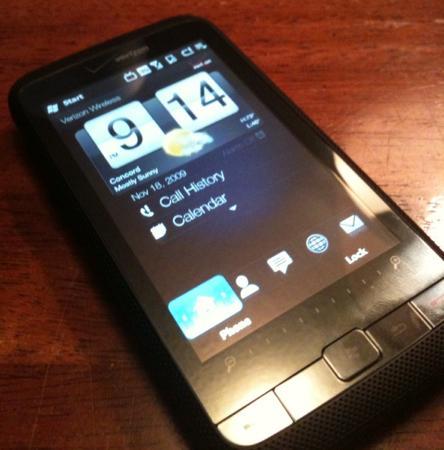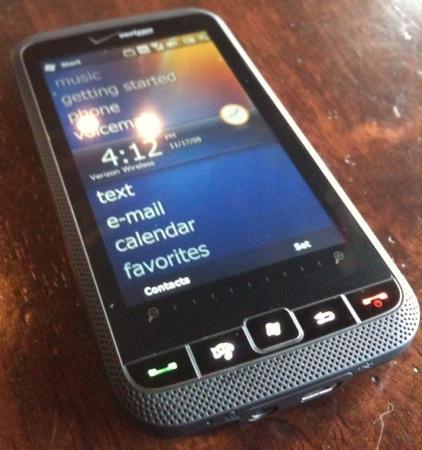
What I like: Neat design; large touchscreen.
What I don't like: On-screen keyboard could use some work; laggy at certain times.
Introduction
Giant 3.6-inch WVGA resistive touchscreen? Check. 528 MHz processor? Check. Windows Mobile 6.5, 3.5mm headphone jack, A-GPS, microSD card slot, FM radio, and more - it's all there. The HTC Imagio comes in at 4.6 inches tall by 2.4 inches wide by 0.5 inch thick and tips the scales at 5.25 ounces. It offers a kickstand on the back (used in the picture above) for watching videos while stationary.
Keypad and Interface
The on-screen keyboard that comes with the Imagio is something that you'll either like or dislike. I had a challenging time typing on it, but I'm used to physical QWERTY keyboards, so I'll withhold judgment. The Imagio sports HTC's TouchFLO interface, which does a fantastic job of covering up Windows Mobile (for those that don't want to deal with it). Other features of the unit include V CAST services, VZ Navigator, the Microsoft Office Mobile suite, Windows Marketplace for Mobile, and the My Phone backup service. Overall, the device performed well in every day use, though there was lag at times (typically when multiple applications were open). The accelerometer performed well.

Camera/Video Camera
The Imagio offers a 5.0-megapixel camera, and in my testing, image quality was good (see above). The Imagio offers six different resolutions, adjustable ISO, white balance, four quality settings, brightness, a self-timer, a panorama stitching mode, a shutter sound toggle, and a wide-screen mode, contrast, saturation, and sharpness.
Reception and Data Connectivity
I've been testing the Imagio in the Charlotte area, and call quality is very good. Though the traditional "bar" metric doesn't always apply in this situation (while the Imagio had zero "bars," the Chocolate Touch had two), I never dropped a call with the Imagio. When testing in a busy coffee shop, my callers could hear me well. I connected my Plantronics Voyager Pro Bluetooth headset to the Imagio without a problem, and Bluetooth calling was great. Wi-Fi worked well, and connected to various networks with ease.
Like the BlackBerry Storm2, the HTC Imagio is a world phone, so it ships with a SIM card for international use. In addition to the CDMA 850/1900 MHz bands, the Imagio supports GSM 850/900/1800/1900 MHz frequencies and the WCDMA 2100 MHz band. According to Verizon, the device supports voice coverage in 220 countries and 3G data coverage in 175 countries. Individual rates vary depending on the country, and can be found on Verizon's website. The Imagio is an EVDO Rev. A device, and as such, I was pleased with data speeds. The full PhoneDog homepage loaded in 26 seconds, and other data-intensive tasks loaded well throughout the testing. Though it's not one of my favorites in the marketplace (I prefer WebKit-based solutions), the Windows Mobile browser gets the job done.
Battery Life
The battery life was on par with devices in its class. I'm still working with battery numbers, but I can say this: it's not too bad for a smartphone. Estimated talk time is 5.4 hours, whereas standby time is just over 13 days. In real-time testing, the device lasted just over two days. Like any wireless device, battery numbers will vary with the level of usage that they're subjected to between charging cycles, but the Imagio does well for a media-centric smartphone.
Check out the pictures below, and stay tuned for my full review!

HTC Imagio with TouchFLO activated.

HTC Imagio without TouchFLO activated